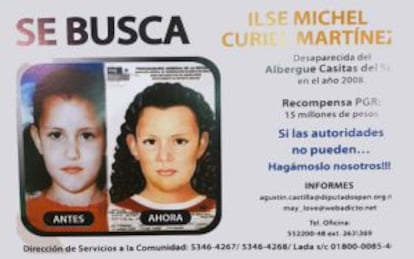Mexico’s “disappeared” children
A 15-year-old girl's reappearance could be the key to uncovering more about a secret sect


The kidnapping of Ilse Michel is now over, but the young girl is refusing to tell the authorities where she has been for the past six years, because, she says, she fears police will arrest the couple and a woman who cared for her.
A few weeks ago, the young girl arrived by taxi at a public family care center in Mexico state. She told officials that her name was Ilse, that she was 15 years old and wanted to see her mother.
Ilse is one of 14 children who suddenly disappeared without a trace while they were in the guardianship of Mexican social service officials. They had been taken from their families for different reasons, including child abuse and violence.
It is thought that more children have disappeared under the same circumstances, but because there are no accurate counts or records of the number of juveniles taken, it is impossible to say how many.
The Attorney General’s Office (PGR), which declined to discuss the cases with EL PAÍS, puts the number at 14.
“There are many more,” says Bernardo Barranco, an expert on religious issues. “Ilse’s case blew the lid off the situation because her mother and grandmother moved mountains to find her. There is a lot of disinformation out there because of the laxity of Mexican authorities.”
Mexico’s biggest scandal involving missing children revolves around an obscure religious organization – one that Barranco claims is “a sect.”
Hundreds of children who were taken from broken homes by social service authorities in at least six states had been turned over to an organization calling itself the Restored Christian Church for foster care.
The children would explain to us how the world was going to end”
In Mexico City, Ilse’s grandmother appeared one day in 2008 at the door of a church center called Casitas del Sur (homes from the south) after she tracked down who had been given guardianship of the child. She wanted to bring Ilse home, but center officials wouldn’t grant her access to her granddaughter. Even PGR prosecutors tried on several occasions to fetch the girl, but supervisors at the home were evasive about Ilse’s whereabouts.
Then in 2009, authorities broke in and rescued 116 children, many of whom had no files on any state agency’s registry. Police found many of them had been brainwashed by religious fanatics.
Sometime later, the children described to authorities how they were punished, including being locked up in closets throughout the night.
Agustín Castilla, a former congressman who took part in the raid, recalled in a telephone interview how the center appeared to be an expansive underground labyrinth, “with a lot of stairs and small rooms.”
“When we were there, the children would explain to us how the world was going to end and that there was going to be a catastrophe. They were well trained, warning the authorities not to violate their rights as children. They would form small groups in the patio, interlocking their arms and trying to protect each other. Then they sat on the ground in a show of peaceful resistance,” Castilla said.
In the middle of that day’s confusion, Ilse escaped from the center with the help of a pastor who later turned her over to a married couple who were said to be part of the sect’s leadership. It is not clear whether they finally gave in and let her go after the now-15-year-old demanded to see her mother or she just escaped.
Her mother, Mayra Martínez, told EL PAÍS via a phone interview that Ilse is “doing very well.”
“We’re just happy, the fear is no long there,” she says.
Mexican authorities assumed guardianship of Ilse just before she was to be handed over to her grandmother. She had been taken from her mother after an abuse complaint was filed. But in 2007, a court dropped the charge.
“But what struck me was his seductive manner – he was very convincing ”
Castilla says that he has asked psychologists who will examine her to ensure that she is well protected and treated because Ilse “is a source of information” about the sect.
He said that she claims she was treated well but never went to school or had access to any radio or television. She said that the family moves two or three times and that she always slept in the same room with the wife’s sister.
The Restored Christian Church had its permits revoked in 2010 by the Mexican government. It once operated a chain of centers across the country that took in homeless children. Several people have been arrested but Mexican prosecutors have refused to say how many or what they are being charged with.
Those who were members say that Jorge Erdely was their leader. A man now in his 50s, Erdely was known in the Mexican academic world for his criticism and studies of dangerous religious sects. An international arrest warrant has been issued for him.
During the 1990s, he made frequent television appearances and participated in panel discussions on radio about the subject. Barranco, the religious expert, remembers inviting him to take part in a radio show in 2001.
“I asked him if there were any dangerous sects today in Mexico and he pointed to the Light of the World Church, which wasn’t a sect at all," he explains. "We had a big confrontation on air because he wouldn’t give me any solid arguments. That was when I realized that he was involved in an internal marketing war with them; he wanted to discredit them.
“But what struck me was his seductive manner – he was very convincing and his impetuosity raised my suspicions.”
Erdely comes from a well-off Mexican family that owns a glue factory, which produces the popular Kola Loka brand. He studied biology in his youth and practiced bodybuilding; even winning the Mr Mexico contest one year.
In the 1980s, he joined the Pentecostal church but soon left after falling out of favor and began his own religious organization. He also studied theology in the United States.
“He used his skills for seduction to become a dictatorial religious leader, who would force marriages and order others to follow his rules – that was exactly what criticized in the books he wrote. He was schizophrenic and bipolar,” said Barranco.
Tu suscripción se está usando en otro dispositivo
¿Quieres añadir otro usuario a tu suscripción?
Si continúas leyendo en este dispositivo, no se podrá leer en el otro.
FlechaTu suscripción se está usando en otro dispositivo y solo puedes acceder a EL PAÍS desde un dispositivo a la vez.
Si quieres compartir tu cuenta, cambia tu suscripción a la modalidad Premium, así podrás añadir otro usuario. Cada uno accederá con su propia cuenta de email, lo que os permitirá personalizar vuestra experiencia en EL PAÍS.
¿Tienes una suscripción de empresa? Accede aquí para contratar más cuentas.
En el caso de no saber quién está usando tu cuenta, te recomendamos cambiar tu contraseña aquí.
Si decides continuar compartiendo tu cuenta, este mensaje se mostrará en tu dispositivo y en el de la otra persona que está usando tu cuenta de forma indefinida, afectando a tu experiencia de lectura. Puedes consultar aquí los términos y condiciones de la suscripción digital.








































